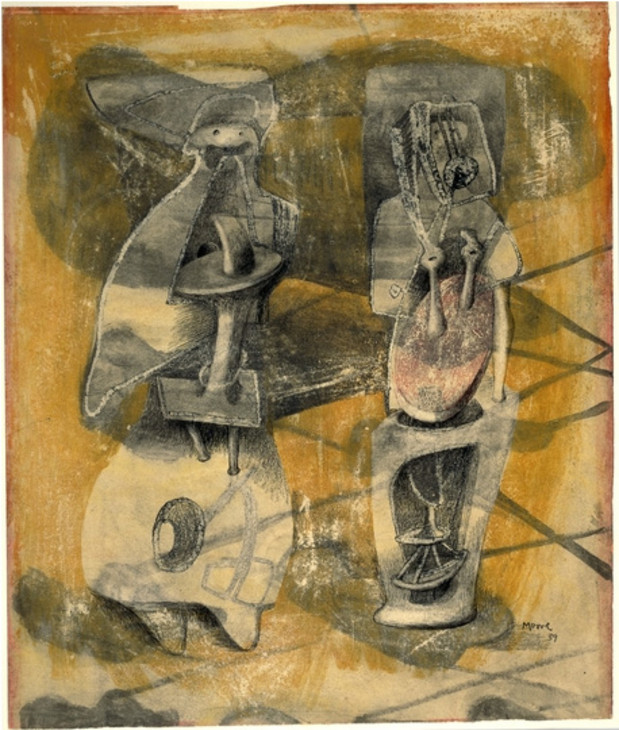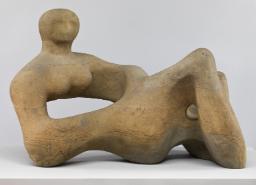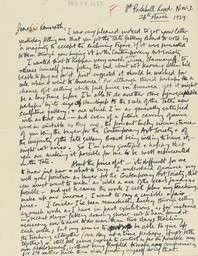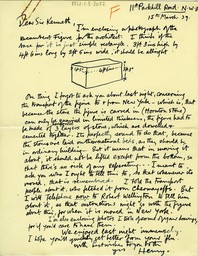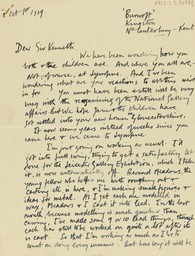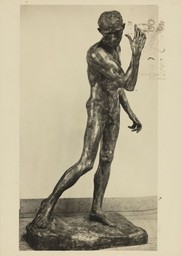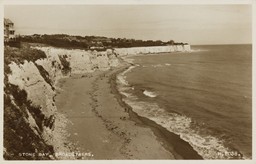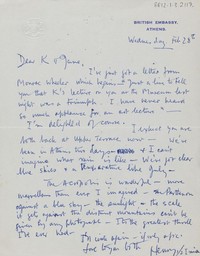‘Worthy of the great tradition’: Kenneth Clark on Henry Moore
Chris Stephens
Kenneth Clark believed Moore to be the towering artistic genius of his generation and felt that he represented civilised values at a time when these were under threat. Clark wrote relatively little about Moore, his major text being a late book on the artist’s drawings, but he exerted more influence on the artist’s development and career than perhaps any other figure.
Of all those who wrote on Henry Moore, it is unlikely that any had as fundamental an impact on his career as Kenneth Clark (1903–1983). Yet Clark’s writing on the artist was relatively scant: a couple of brief catalogue introductions, a short article on his metal sculptures in 1951, numerous lectures and speeches, and mentions in broader articles and books, and a book about Moore’s drawings in 1974, are about the sum of his output on the subject. But such was Clark’s position in the structures of the British art establishment that he, believing Moore to be the greatest artist of his generation in Britain if not beyond, was better able than anyone to ensure Moore’s prominence. To get a grasp of the nature of Clark’s influence, as well as its extent, one must seek to establish what he believed Moore’s art to be about and, consequently, for what Moore himself stood. His writings on Moore offer insights into Clark’s view of Moore and his art and also point to how he perceived Moore’s position in a wider history and in the wider culture.
Clark’s influence on the contemporary art scene was enabled by his unique situation, poised as he was for many years between the art world and the political and social establishment. An education at Winchester College and Oxford University had secured for him a position among (almost exclusively) men of influence and power, while immense wealth, inherited from his family’s activities in the Scottish cotton industry, enabled him to occupy his place in such a world comfortably. Unusually for someone of that social background, Clark was an aesthete and rose rapidly through the then barely existent disciplines of art history and curatorial practice. Soon after he graduated, Clark went to work for two years with the connoisseur Bernard Berenson in Tuscany, assisting in the revision of the latter’s seminal catalogue of Renaissance artists. This experience secured him a job cataloguing the collection of drawings by Leonardo da Vinci at Windsor Castle, from which he ascended to be, briefly, Keeper at the Ashmolean Museum in Oxford and then, aged just thirty, Director of the National Gallery from January 1934.
Clark was a prodigious collector of fine and decorative art: by his own account, few types of object or periods of production failed to attract the attention of what was considered to be a discerning eye. One of his first, childhood passions were Japanese woodblock prints, and from an early age he was seen as the embodiment of a cultured aesthete, living a life surrounded by beautiful paintings and drawings, fine china, objets d’art, great music and good wine. Particularly numerous in his collection, the larger part of which was bought in the later 1920s and the 1930s, were paintings and, especially, drawings of the Italian Renaissance including a small, round painting by Raphael and a drawing considered by Clark to be, in part at least, by Michelangelo.1 Equally noteworthy were works from nineteenth-century France: Corot, Millet, and other artists of the Barbizon School like Théodore Rousseau and Charles-François Daubigny; most particularly, works of impressionist painters (Camille Pissarro, Alfred Sisley, a Pierre-Auguste Renoir nude Clark believed to be a masterpiece); and post-impressionists – he had two great Georges Seurat oils and six oils and over fifty drawings by Paul Cézanne. At the heart of Clark’s lexicon of artistic value was the importance of observation and a vital connection with the natural realm. To this extent, one might see an art historical trajectory that for Clark extended from Chinese and Japanese paintings, through the Deluge drawings of Leonardo to the works of Cézanne. (Clark’s belief in the importance of tradition led to a penchant for works after other works. A number of his Cézanne drawings were studies after Delacroix and others, for example, and he had Edgar Degas’s Two Heads of Men after Giovanni Cariani (formerly attributed to Gentile Bellini) c.1854.2 Perhaps in acknowledgement of this, Moore based the lower part of his Two-Piece Reclining Figure No.1 1959 on the cliff formation in Seurat’s Le Bec du Hoc that Clark had hanging in his drawing room.)
Alongside this avid collecting, Clark became during the 1930s one of, if not the, most active collector of contemporary British art. Beginning with Bloomsbury artists, his buying was wilfully eclectic and demonstrated a commitment to the modern combined with a reservation about abstraction. The economic difficulties of the 1930s posed challenges for artists, many of whom were forced to seek work in such areas as poster and furniture design.3 From around 1934 Clark identified a crisis in patronage, singling out London Transport and the oil company Shell-Mex as pretty much the only patrons of contemporary artists. Clark set out to do something about it himself and became a patron as well as, and distinct from, a collector.
Clark had commissioned works from early on, arranging for the aging Philip Wilson Steer to paint a portrait of his wife and commissioning items for his house, like a fireplace decorated with tiles by Bernard Leach and fabrics designed by his friend Marion Dorn. Clark’s first contact with practising artists was with the Bloomsbury painters Duncan Grant and Vanessa Bell following his meeting, as an undergraduate, with the critic Roger Fry. From them he commissioned numerous paintings and decorative objects, including an enormous dinner service. Clark’s view of patronage was undoubtedly influenced by his knowledge of art history and of the Renaissance in particular. One of those who most benefited from his support was Graham Sutherland who later described Clark as like ‘a Renaissance prince’ (the assertively side-on view employed in Sutherland’s 1963 portrait of Clark seems deliberately to invoke memories of Piero della Francesca’s depiction of Federico da Montefeltro, the Duke of Urbino). Clark’s idea of patronage, however, was one of dialogue rather than simple financial or practical support. ‘It needs two people to make a picture’, he wrote, ‘one to commission it and the other to carry it out ... the ideal patron ... is a man with enough critical understanding to see the direction in which the artist ought to go’.4 So, as a private individual one can see Clark helping certain artists to develop by buying their work, commissioning work which might steer them in a particular direction, offering advice and introductions, and brokering other sales or deals with friends and contacts. If this allowed him to support those artists whose work he most valued and admired, his position also offered the opportunity to promote and progress those artists he believed most deserving of public status both in terms of their own ability and in terms of what he believed would be right for British art.
Clark was anxious about the ways in which modernist art was progressing and in October 1935 published an important article contemplating ‘The Future of Painting’ in the Listener.5 Both abstract and surrealist artists claimed to be the future of painting, he wrote, but neither would be because both movements were too far removed from the experience of people outside the art world. The failure of the ascendant middle class to fill the gap left by the decline of the church and the aristocracy as patrons had led to a lack of enlightened patronage and, as a result, artists were making work for themselves and on their own terms, in isolation. Objecting to the dogma of both modernist movements, which he characterised as ‘essentially German, both in the importance attached to theory and in the protestant structure’, Clark contrasted their sectarianism with ‘the catholic understanding that allowed Degas to copy Sir Thomas Lawrence as well as Ingres, or allowed Renoir to study Raphael’.6 Artists, Clark suggested, would benefit from reference back to earlier tradition and to the external, natural world, and they needed ‘a new myth’ through which they could find common cause and common communication with the rest of society. Pessimistic by inclination, he contemplated that perhaps the period would become one of those in which no painting of import was produced at all, citing late sixteenth-century Italy and the age of Shakespeare as precedents.
The first coherent group of artists to benefit from Clark’s desire to support and promote a form of modern painting preferable to those introspective continental models that he had attacked in the Listener were the Bloomsbury protégés of the Euston Road School: Graham Bell, William Coldstream, Victor Pasmore and Claude Rogers. The school was established to promote the central importance of objective observation and representation in painting, an ambition with clear left-wing associations for the painters if not, quite, for Clark. To this end the painter the protagonists idolised and, in most cases emulated, was Cézanne. Clark not only supported the school by helping to pay for premises, prospectuses and, towards the end of its life, a retrospective exhibition, but also effectively paid the teachers a salary to free them from other obligations. Bell and Coldstream had been working in film and Pasmore was a full-time civil servant at the London County Council until Clark’s regular stipend freed them all to paint full-time. What exactly the arrangements were is not clear: an exchange of pictures as well as money seemed to be a part of the deal, but whether Clark undertook to buy a certain number of works, or whether he paid a monthly sum and the artists let him have pictures in exchange is not certain.
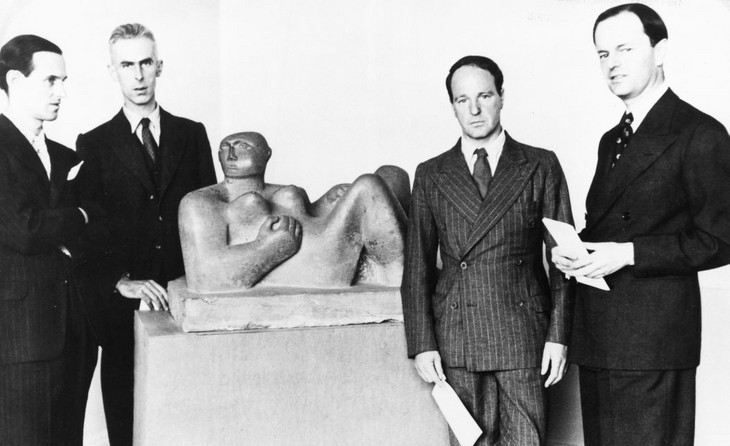
Graham Sutherland, John Piper, Henry Moore and Kenneth Clark at Temple Newsam, Leeds in 1941
© The Henry Moore Foundation. All Rights Reserved
Photo: Henry Moore Foundation Archive
Fig.1
Graham Sutherland, John Piper, Henry Moore and Kenneth Clark at Temple Newsam, Leeds in 1941
© The Henry Moore Foundation. All Rights Reserved
Photo: Henry Moore Foundation Archive
Although Clark’s enthusiastic promotion of these artists seems to have begun in the last couple of years of the 1930s, his knowledge went back some way further. He acquired his first drawings from Moore’s first solo exhibition, at the Bloomsbury-connected Warren Gallery, in 1928.8 Clark’s unrivalled collection of Moore drawings included very early work from the 1920s but it has not been possible to identify which drawing he bought on that occasion. He continued to acquire work – mostly, although not exclusively, drawings – in subsequent years but may not have met Moore in person until 1938. Moore told John and Vera Russell that he had first met Clark around 1929 or 1930, but his biographer Roger Berthoud concluded that Clark’s first visit to Moore, at Burcroft in Kent, was in 1938.9 Certainly, in the latter part of that year Moore was still addressing Clark as ‘Sir Kenneth’ in his correspondence. Despite their apparently contrasting characters and backgrounds, the two became very close so that Clark would later look on Moore as one of his two closest friends. In return, Clark’s wife Jane was made godmother to Moore’s daughter Mary in 1946. In fact, there is some evidence that Moore perhaps felt at ease more quickly with the warmer Jane than with the more aloof Kenneth. Moore wrote to her affectionately from spring 1940 but in November of that year still referred to her husband in a letter as ‘Kenneth’, though all his friends and many acquaintances knew Clark as ‘K’.10
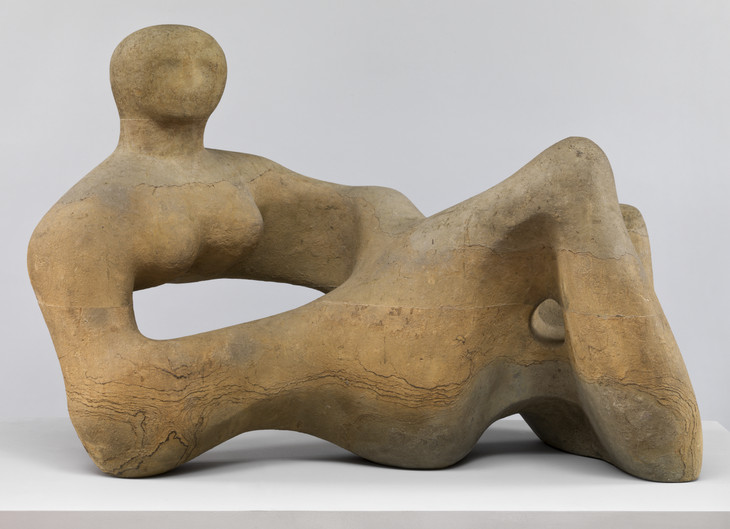
Henry Moore OM, CH 1898–1986
Recumbent Figure 1938
Green Hornton stone
object: 889 x 1327 x 737 mm, 520 kg
Tate N05387
Presented by the Contemporary Art Society 1939
© The Henry Moore Foundation. All Rights Reserved
Fig.2
Henry Moore OM, CH
Recumbent Figure 1938
Tate N05387
© The Henry Moore Foundation. All Rights Reserved
Clark also offered his opinion on Moore’s latest work and advised him on what to offer other collectors and for exhibition and reproduction. In September 1938 Moore had sought Clark’s advice and early in 1939 Clark helped with both the selection and the sale of drawings for the exhibition at the Mayor Gallery in London that had caused Moore to turn down the Rosenberg and Helft show.15 ‘Henry was so pleased to have K’s opinion on his drawings’, Irina Moore wrote to Jane Clark following a visit.16 Moore’s trust in both Kenneth and Jane Clark’s judgement is suggested by a letter in which he reported that he started on the numerous alternative forms of the Family Group that had been commissioned for Impington Village College in Cambridgeshire: ‘I’m beginning on the clay models for Impington – & shall love you & K to come & help decide about them’.17 It is said that, when he was working closely with the sculptor, David Sylvester lamented Moore’s trust in Clark’s judgement of his work.
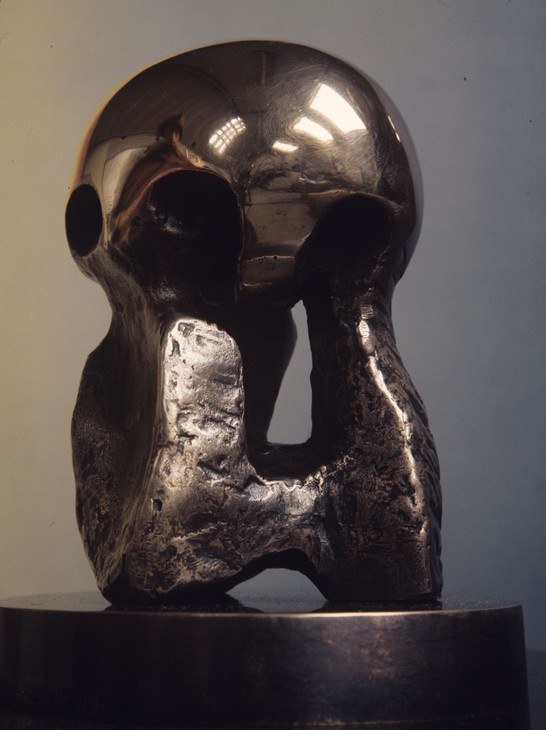
Henry Moore
Maquette for Atom Piece 1964 cast 1970
© The Henry Moore Foundation. All Rights Reserved
Photo: Henry Moore Foundation Archive
Fig.3
Henry Moore
Maquette for Atom Piece 1964 cast 1970
© The Henry Moore Foundation. All Rights Reserved
Photo: Henry Moore Foundation Archive
The Atom Piece maquette was probably the most abstract of all of the sculptures but this was less true of the drawings that Clark owned. His was, perhaps, the finest collection of Moore’s drawings anywhere and in the late 1960s Clark discussed with the artist a selection of them to be bequeathed to the Tate Gallery where they would complement the large collection of sculptures that Moore had offered as a gift. In the event, at some later stage the bequest was redirected to the British Museum. Clark’s collection included some of the most finished and accomplished of Moore’s drawings of the 1930s and several of these are quite abstract and challenging in their form. Nevertheless, his preferences might be concluded from the fact that while Clark seems to have had one drawing each from 1934, 1935 and 1937, two from each of 1936 and 1938, and five from 1939, from the years when Moore turned towards a more realistic mode of representation Clark owned twelve works from 1940 to 1941 plus the sketchbook used over the winter of those two years. The collection suggests a preference for the finished drawing as opposed to a more provisional study; there are no examples of the Transformation drawings which Moore seemed to use in the early 1930s to make the transition from a found natural object to a sculptural idea. All of the 1930s drawings might be seen as ideas for sculpture, however, and at least one was realised and Clark owned both drawing and sculpture. Clark would later write of Moore’s drawings as sometimes ‘spooky’ and seems to have been fascinated in an unsystematic way in the fact that such works seemed to tap into areas of Moore’s subconscious that otherwise remained hidden. The Two Upright Forms of 1936 are anthropomorphic presences reminiscent of standing stones, while a comparable drawing seems to suggest sarcophagi, and Drawing for Sculpture: Two Women (fig.4) exemplifies an almost violent opening up of the body that is found occasionally in Moore’s work of that time.
Clark’s support for Moore, in the form of advice, brokerage, and commissioning, as well as private purchase, reached new levels with the advent of the Second World War and his more ready response to the drawings over the sculptures was at the heart of that. At the beginning of the war, Clark was quick to offer moral and, where necessary, material support to his artist friends alarmed at the sudden closure of galleries and art schools where teaching offered a valuable, regular income for an artist like Moore. With Clark’s encouragement, Moore spent the first months of the war – the ‘phoney war’ – casting small figures in lead, one of which was that acquired by Clark along with the related drawing. At the same time, Clark – now at the Ministry of Information – proposed and became the chair of the government’s War Artists Advisory Committee, which was established to provide income and protection for artists as well as a record of the conflict. Such a scheme naturally favoured artists working in more traditionally representational idioms and, in particular, those making pictures. It might, then, have seemed an inauspicious initiative for an artist known, generally, as an avant-garde sculptor with loose associations with the surrealist and other modernist groupings. Yet Moore’s contribution would become the most celebrated and recognisable of the many hundreds works produced and, as a consequence, his reputation would be radically transformed in the process.
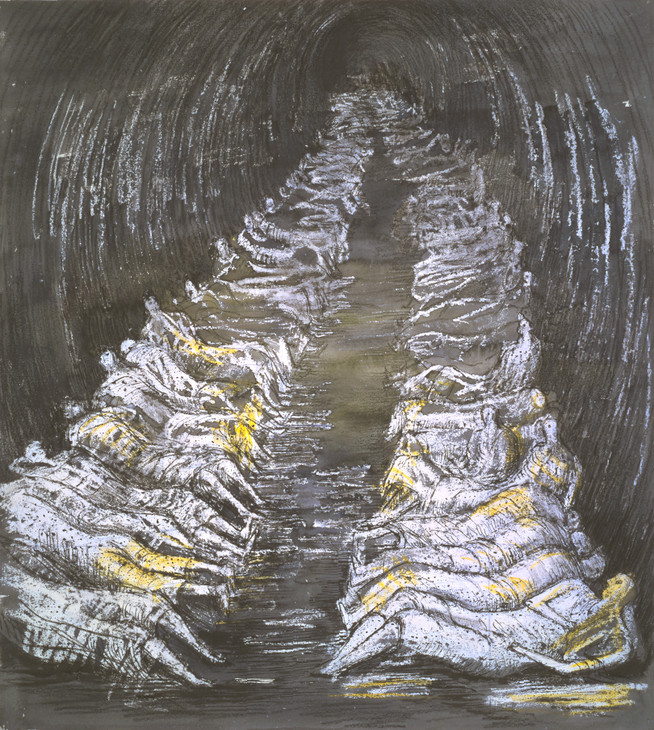
Henry Moore OM, CH 1898–1986
Tube Shelter Perspective 1941
Graphite, ink, wax and watercolour on paper
support: 483 x 438 mm
Tate N05709
Presented by the War Artists Advisory Committee 1946
Fig.5
Henry Moore OM, CH
Tube Shelter Perspective 1941
Tate N05709
A clue to Clark’s motivation may be discerned in a review of the achievements of the WAAC:
On the whole it gives the impression that English painting is becoming a great deal more English. This does not mean that it returning to the dreary provincialism of the late nineteenth century, but that the influence of international ‘French’ painting, for twenty years a necessary tonic, is now declining and the national virtues are free to reassert themselves.26
Central to Clark’s admiration for and advocacy of Henry Moore’s art were these dual aspects of an art that was at once original and relevant to common experience and of an art that could be located within a tradition, in particular a national tradition. Like many of his generation, Clark saw culture through the lens of essential national characteristics: for Clark, the Italians are passionate and demonstrative, the Germans overly theoretical, and the English are a poetic people whose outlook is determined by the weather. This informed his account of English painting in 1935 and, in the middle of the war, he seemed to explain the government’s policy of appeasement during the 1930s by proposing that the soft-grey light of England’s climate had led its people to forget that those in continental Europe tended to see things in extremes, in the stark contrast of bright sunlight and deep, sharp-edged shadow.27 So, he saw the most promising contemporary British art to be that which revealed an understanding of and response to the innovations of, in particular, Pablo Picasso, but which also demonstrated a continuity with native tradition. The new romanticism that Clark identified in the art of the late 1930s and 1940s fitted that bill and the war offered an opportunity to encourage those artists away from what he would see as the more arcane extremes of modernist invention. After the war he introduced this idea to an American readership, identifying Graham Sutherland and Henry Moore as the leading representatives of ‘The New Romanticism of British Painting’. In an article published while Moore’s triumphant retrospective was on at the Museum of Modern Art in New York, Clark felt obliged to justify Moore’s inclusion:
It may seem straining a point to include Moore under my title at all, for he is primarily a sculptor, and much of his sculpture appears to be almost completely abstract. But even in non-representational sculpture there is a suggestion of strange distances, the forces of wind and weather, the bones of primeval monsters, and the landscape of some uninhabited planet’.28
The wartime drawings were more easily accommodated within this ‘new romanticism’. Not only were they more realistic in their description of the human form and its situation, Moore’s widespread use of off-set techniques to create an organic, all-over quality in his surfaces invited comparison with predecessors like Samuel Palmer (Clark had encouraged Sutherland’s interest in Palmer and owned one of the artist’s major works) and William Blake, specifically the mottled surface of the rock in his 1795 Newton.
The demands of the WAAC commissions for pictures of the shelters and then, later, of coal mining had obliged Moore to develop a more representational style. He would retain that mode of practice for some years after the war, with his Madonna and Child and Family Group series being clearly descended from the shelter and related drawings. At the same time, the war had imposed upon many people in Britain unprecedented physical and psychological experiences. These two things meant that the art that Moore and some of his colleagues produced for the WAAC spoke more readily of and to common experience. It was not just that the artists had had to compromise the extremes of their artistic expressions but also that everyday experience had become a lot more extreme. Clark was naturally sympathetic towards this move into a subject matter more closely related to others’ lives and experiences. It would, however, be too simplistic to say Clark only encouraged a more figurative side of Moore. After the war, having been disappointed by the Claydon Madonna, Clark actively discouraged E.M. Forster from approaching Moore with a possible commission for a sculpture for the chapel of King’s College Cambridge. ‘He is not at all a Gothic artist’, Clark warned, ‘and is really much happier when he has not got to make such concessions to the subject as would be necessary in your chapel’.29 Of the Shelter drawings, it was precisely their synthesis of formal qualities and emotion that secured their supremacy. Noting that Moore’s and Sutherland’s work had a ‘latent’ ‘sense of drama and heightened emotion’ that suited it to the subject of the Bliltz, he wrote that the Shelter drawings, ‘Are most clearly in the high tradition of the Old Masters, for Moore’s long and concentrated study of abstract shapes has allowed him to dwell on the emotional content of his subject without any loss of formal consistency’.30 The claim for Moore as in the great tradition of the Old Masters would recur.
The war not only prompted Moore to make the drawings that would mark a crucial shift in his practice but it also took his art to new and much wider audiences. The products of the War Artists’ scheme were seen on the walls of the National Gallery, which Clark had made the effective headquarters of the scheme, and in a series of exhibitions which toured Britain and beyond. Clark initiated and was involved in a number of other projects and schemes which served to take art and, in particular, the work of his favoured artists, to a wider audience. He was involved in the Council for the Encouragement of Music and the Arts (CEMA), as well as an influential advocate for continued funding for its post-war successor, the Arts Council of Great Britain, and the Institute for Adult Education’s ‘Art for the People’ exhibitions. That these found new audiences for art was demonstrated by research in 1943 that showed that the last thirty exhibitions organised by those bodies had attracted an audience of half a million people.31 Clark also recognised the importance of art’s circulation in reproduction and initiated a series of high-quality, low-cost books on ‘Modern British Painters’. That he was able to secure good-quality paper and colour printing in the midst of wartime is indicative, perhaps, of his influence and the value put upon such schemes. As Penguin paperbacks had revolutionised popular reading, so Clark hoped these might do the same for painting. The books certainly sold well. The influence of Clark upon popular perceptions of Moore’s art might be clearly discerned in the fact that the very first volume of this series on the painters of the time was dedicated to his work. By inviting Geoffrey Grigson to write the text, Clark ensured that Moore’s pictorial work would be presented in the frame of romanticism and his debt to nature. The Moore volume ran into several editions and revisions, and its impact on a British readership can only have been reinforced by the publication in 1945 of a facsimile of the ‘First Shelter Sketchbook’, the original of which was by then in the ownership of Jane Clark. The Shelter drawings became key elements in the forging of the ‘myth of the Blitz’ (it is surely not coincidental that Moore’s first exhibition in the USA was of drawings and followed shortly after examples of his shelter drawings had been exhibited at the Museum of Modern Art in the Britain at War exhibition in 1941). By the end of the war, Moore had been transformed from a leading avant-garde artist known to those who paid attention to such things into the most widely recognised artist in Britain, if not beyond. This was due to the promotion of his work and to the promotion of and wider access to art in general, both of which owed more to Kenneth Clark than to anybody else.
Writing of Moore’s Shelter Drawings, Clark sought to locate them in another art historical tradition than simply the national one. ‘Henry Moore’s shelter drawings record all the misery, stoicism and nightmarishness of the scenes, and give them an indestructible quality which only comes from a great style. Of all the work produced by the War Artists, these are most clearly in the high tradition of the Old Masters.’32 The elevation of Moore to the pantheon of great western artists was a recurring motif in Clark’s commentary on him. Clark begins and ends his landmark book The Nude (1956) with Moore, both the culmination of a tradition and the inheritor of the modernist radicalism of Picasso. He opens with the proposal that the persistence of the nude human figure as a motif (he says the ‘central subject’) of art is the last vestige of the ancient Greek legacy. ‘When we wish to prove to the philistine that our great revolutionaries are really respectable artists in the tradition of European painting, we point to their drawings of the nude’. Picasso is cited, as is Moore who is described as, ‘searching in stone for the ancient laws of its material and seeming to find there some of those elementary creatures of whose fossilised bones it is composed, yet gives to his constructions the same fundamental character which was invented by the sculptors of the Parthenon in the 5th century before Christ’.33 And he finishes with Moore, setting him up as the current inheritor of this tradition. ‘The Greeks’, he writes, ‘wished to perpetuate the naked human body because it was beautiful ... So, ‘to abstract from the model ... as was the practice on neo-classical discipline no less than ... in the last thirty years, is fundamentally un-Greek.’34 But, he reassures his reader, ‘This does not mean that the attempt to create an independent form on the basis of the human body is a lost cause; only that the old approach by which art-school nudes are scrambled into a new pictorial language involves too great a sacrifice of fundamental responses.’35 The metamorphosis of the form needs to take place in the artist’s unconscious and not through a process of ‘trial or elimination’ and he cites Moore as an example: ‘Almost alone of the generation succeeding Picasso, he has not felt himself swamped or frustrated by that ruthless torrent of invention ... Where Picasso is volatile, Moore is tenacious; Picasso swoops, Moore burrows. A see-saw between love and hate, elegant classicism and enraged distortion is entirely foreign to his single-minded character.’36
Clark claims a technical and emotional integrity for Moore, pointing out that his sculptures are not based on drawings but are already fully-formed in the artist’s imagination: ‘They are, so to say, abstract from the first; the metamorphosis has been intuitive, the result of some deep internal pressure. Yet they are clearly the work of a man in whom the body has aroused powerful emotions’.37 Such buried and unconscious motivations are repeatedly cited by Clark as key to Moore’s work: ‘His imagery’, Clark said in a lecture in Oxford in May 1950, ‘is often drawn from parts of our being which we do not readily externalise’.38 He notes that the Recumbent Figure of 1938 and the elmwood Reclining Figure carved between 1944 and 1946 each have their roots in figures from the Parthenon (the Dionyssus and the Ilissus, respectively). ‘Thus’, he concludes once and for all, ‘modern art shows even more explicitly that the art of the past that the nude does not simply represent the body, but relates it, by analogy, to all structures that have become part of our imaginative experience.’ For the Greeks this was geometry, but for the modern period greater experience means such structures must be much more complex. ‘The Greeks perfected the nude in order that man might feel like a god, and in a sense that is still its function’ as, ‘we still feel close to divinity in those flashes of self-identification when, through our own bodies, we seem to be aware of a universal order’.39
Two things emerge from this account of Moore’s art: one is the desire to position it within, as the terminus of, a great Greco-Renaissance tradition in which the sculptors of the Parthenon and Michelangelo are key markers; the other is the somewhat vaguer suggestion that the artist’s relevance in the modern world derives from the fact that his works are ‘the result of some deep internal pressure’, that they are intuitive expressions of his unconscious. Clark begins his only extended study of Moore’s work both evading and reiterating this last point: ‘I have avoided deep psychological explanations, partly because I am not qualified to make them, partly because Moore himself dislikes them. As far as possible I have talked about the actual drawings and not about the motives behind them. However, the fact remains that the best of Moore’s work comes from somewhere very far down in his being’.40 As early as 1935, Clark had conceded to the surrealists the relevance that derived from their engagement with theories of the unconscious which had ‘influenced the lives and habits of thought of every educated person.’41 This aspect is especially repeated through the early chapters of the book, dealing with the drawings of the 1930s. The psychological charge of these works is clearly important to Clark but it is not a dimension that he seems to find easy to describe or evoke. His terminology is vague – ‘these drawings are entirely personal; they come from a part of [Moore’s] imagination of which he himself seems hardly to have been aware, and sometimes they are slightly spooky’42 – and his analogies sometimes somewhat bathetic, Moore’s imagery being likened to ‘Martians’ or ‘goblins’.43 Such comparisons belie, perhaps, Clark’s recognition of the profundity that may underlie Moore’s themes. Of the great 1944–6 elmwood Reclining Figure, for example, he observes, ‘That this magnificent transformation of the reclining figure should have come into being a year after Moore had been making dozens of studies of “real” people lying down in the shelters, is an example of how firmly his inner demon gripped his imagination.’44
Clark is at pains to set his account of Moore’s drawings in relation to his sculptural practice. He observes how Moore’s early life drawings show him learning about the mass and weight of the human body, and he notes the importance of gravity in such images. These are lessons necessary for a sculptor and ones which Clark insists relate to the human body: he rejects the application of later writers’ comparison with fallen rocks or rising forms to the early images of figures, claiming instead the relevance of Moore’s anecdote of rubbing ointment into his mother’s back.45 Yet he pays little, if any, attention to the Transformation drawings which have occupied others’ attention. It is in this series of works on paper from the early 1930s that one sees Moore’s gradual morphing of found, natural objects. It was, perhaps, seen by Clark as a dangerously surreal practice that would undermine his insistence on the sincere, intuitive nature of Moore’s production of images that could be read as suggestive of erotically or neurotically-defined bodies. The combination of basic physical qualities of the human body and of sculpture with this intuitive expression of unspoken inner drives on the part of the artist lies, for Clark, at the heart of Moore’s obsession with the reclining figure. It is a motif that persists throughout the artist’s career, offering the potential to suggest a variety of forms while remaining a figure: ‘It can also become a part of nature, a fallen tree or a geological calamity, without ever losing some part of its human characteristics ... at once more abstract and more physical’.46
Clark seems more comfortable discussing works in which the subject matter is, perhaps, more recognisable. There is the suggestion that the ‘great tradition’ is Moore’s natural milieu. Of the early work, for example, Clark proposes that Moore was hard pressed ‘to achieve a personal style’ through his ‘particularly tough struggle because of his intense and catholic responsiveness to the art of the past. He could not sweep traditions aside’.47 At the same time, Moore’s desire for modernist credibility meant he could not admit to the influence of ‘Masaccio and Michelangelo’. ‘Instead’, Clark writes, ‘he sought for his style in “primitive” art: Negro, Cycladic, Etruscan, and above all Central American. Personally I think that these influences were much exaggerated by the earlier writers on Moore’s sculpture’.48 In contrast, Clark observes that Moore’s use not of landscape but of things found in landscape invests his sculptures with an organicism akin to the practitioners of Art Nouveau ‘with the all-important difference that they rejected (or were incapable of) the basic sequences of classical art, whereas in Moore’s work there is always at the back of his mind the memory of Michelangelo and the Greeks.’49 Again and again, it is the classical lineage to which Moore is related.

Henry Moore
Crowd Looking at a Tied-Up Object 1942
© The Henry Moore Foundation. All Rights Reserved
Photo: Trustees of the British Museum
Fig.6
Henry Moore
Crowd Looking at a Tied-Up Object 1942
© The Henry Moore Foundation. All Rights Reserved
Photo: Trustees of the British Museum
Recurring again and again is the citation of the great tradition of art making. This relates not only to a particular kind of representation but also, simply, to the quality and status of the art and the artist. Clark begins his book with the claim that a drawing from life from 1929 ‘would be an outstanding drawing in any epoch since the Renaissance’.54 Moore’s two Shelter sketchbooks are, for Clark, ‘among the most precious works of art of the present century’; and in them one might find figure groups ‘worthy of a Greek pediment’.55 Similarly, distancing himself from the artist’s own dismissal of his coal-mining drawings, Clark proposes that, ‘If the miner’s back on Pl. 163 is not a piece of drawing worthy of the great tradition, then I have been wasting my time during the last fifty years.’56 Moore’s position at the convergence of many great traditions was suggested by a joint television appearance in 1958, when he and Clark were filmed for ATV visiting the British Museum at night and viewing and discussing a variety of sculptures by torchlight. Sadly, the film seems not to survive but photographs indicate that they looked both at the Parthenon sculptures and at the work of other cultures, such as the great Easter Island figure Hoa-haka-mana-i.
The depth of Clark’s respect for Moore was demonstrated in May 1968 when he interrupted the filming of Civilisation so that he might make the address when the artist was presented with the prestigious Erasmus Prize. Even allowing for the hyperbole such occasions often elicit, his comments were striking. One member of the audience recalled him saying that if humankind were to send a single person to another planet to demonstrate the very finest qualities of our species, he suggested, there would be no better ambassador than Henry Moore.57 More conventionally, Clark asserted that Moore was the only one among the artists who emerged in ‘that strange and rather ghastly twilight of the old European order’ of the 1930s who could be compared with the great figures of the preceding generation (‘Picasso, Braque, Matisse, Stravinsky’). ‘He alone, I think, has added to the sum of human experience something which was not there before, something which fills the imagination with new forms, satisfies certain deep felt needs, and leaves us, in the end, with a firmer faith in human greatness.’58
At some point shortly after the Erasmus Prize presentation, Clark concluded his filming of Civilisation in his study and library at home in Saltwood Castle. There, finally, he suggested a few values and attributes that, implicitly, he considered constituted civilised values and behaviour:
I believe that order is better than chaos, creation better than destruction. I prefer gentleness to violence, forgiveness to vendetta. On the whole I think that knowledge is preferable to ignorance, and I am sure that human sympathy is more valuable than ideology ... I believe in courtesy ... And I think we should remember that we are part of a great big whole, which for convenience we call nature.59
Against this set of simple values, he voiced a concern that the future of civilisation remained, if not precarious, perhaps inglorious, because ‘there is still no centre’ as Marxism’s failure to offer an alternative to ‘heroic materialism’ had left a moral void. ‘One may be optimistic’, Clark concluded, ‘but one can’t exactly be joyful at the prospect before us’. With that, he rose from his perch on the edge of his desk and walked out into the grand Great Hall that served as his library. Passing under a fourteenth century polyptych by Spinello Aretino, he returned to its shelf the volume of Yeats’s poems from which he had just read, turned to the camera and began to walk out of shot. The last seconds of Clark’s thirteen-episode history of western civilisation showed a flicker of a reassured smile play across his mouth as he reached out and gently stroked – clutched perhaps – the head of Moore’s 1932 Composition. It is as if, faced with the prospect of unbridled and unguided materialism, Clark found in this small carving, with its broad grain adding movement to the slope of shoulder to bent arm, and the line of head through hair to back, the embodiment of those values he most cared about: sensitive, human values, continuing the great traditions of civilisation, and in touch with the ‘great big whole’ of nature. Here and not in his writings perhaps we get to the heart of Clark’s appreciation of Moore: an artist who embraced and embodied many of the forces and values of modernity but who also stood for civilised values and the reassuring deep time of history.
Notes
For more on Clark’s collecting see Chris Stephens, ‘Patron and Collector’ in Chris Stephens and John-Paul Stonard (eds.), Kenneth Clark: Looking for Civilisation, exhibition catalogue, Tate Britain, London 2014, pp.79–100.
Kenneth Clark, ‘The New Romanticism of British Painting’, Art News, vol.45, no.12, February 1947, pp.56–58.
Henry Moore, postcard to Kenneth and Jane Clark, 11 September 1938, Kenneth Clark papers, Tate Archive TGA 8812.1.3.2026; Henry Moore, letter to Kenneth Clark, 22 February 1939, Kenneth Clark papers, Tate Archive TGA 8812.1.3.2031.
The Lund Humphries catalogue numbers for these works are, respectively, Mask LH99a, Mother and Child LH15a, Composition LH80a and a series of lead figures LH103a.
Alan G. Wilkinson, The Drawings of Henry Moore, exhibition catalogue, Tate Gallery, London 1977, p.28.
David Alan Mellor ‘”And oh! The Stench”: Spain, The Blitz, Abjection and the Shelter Drawings’, in Chris Stephens (ed.), Henry Moore, exhibition catalogue, Tate Britain, London 2010, p.55.
E.M. O’R. Dickey, secretary to the WAAC, letters to Henry Moore, 5 January and 24 April 1941, cited in Berthoud 1987, p.197.
Kenneth Clark, ‘The New Romanticism of British Painting’, Art News, vol.45, no.12, February 1947, pp.56–58.
Kenneth Clark, ‘Henry Moore’, typescript of a lecture given in Oxford, 8 May 1950, Clark papers, Tate Archive TGA 8812.2.2.604.
Kenneth Clark, ‘Henry Moore’, typescript of a lecture given in Oxford, 8 May 1950, Clark papers, Tate Archive TGA 8812.2.2.604.
How to cite
Chris Stephens, ‘‘Worthy of the great tradition’: Kenneth Clark on Henry Moore’, in Henry Moore: Sculptural Process and Public Identity, Tate Research Publication, 2015, https://www

